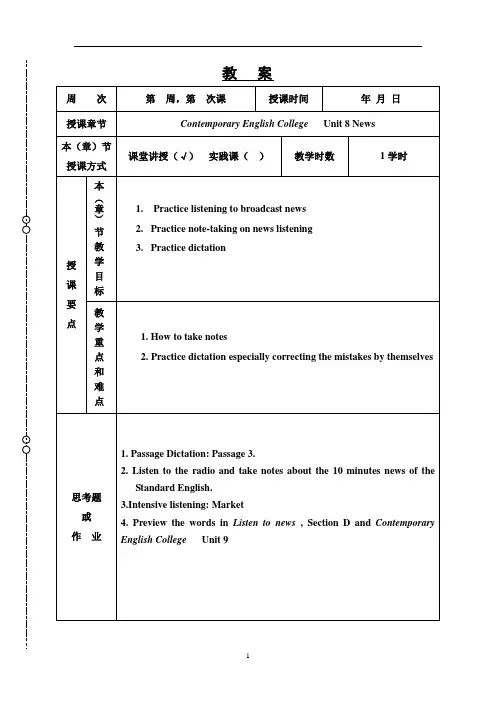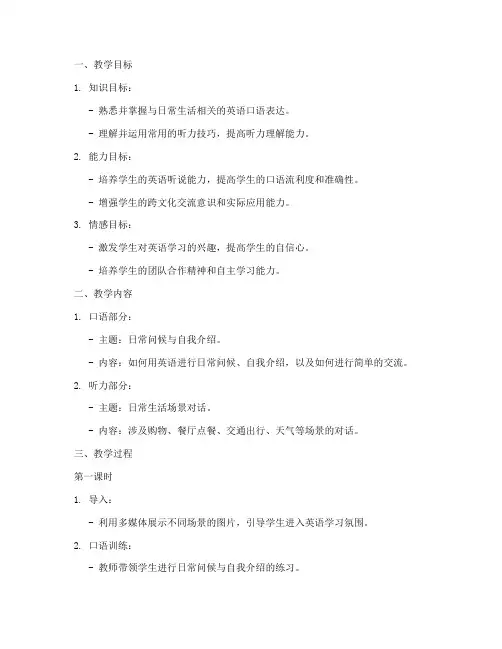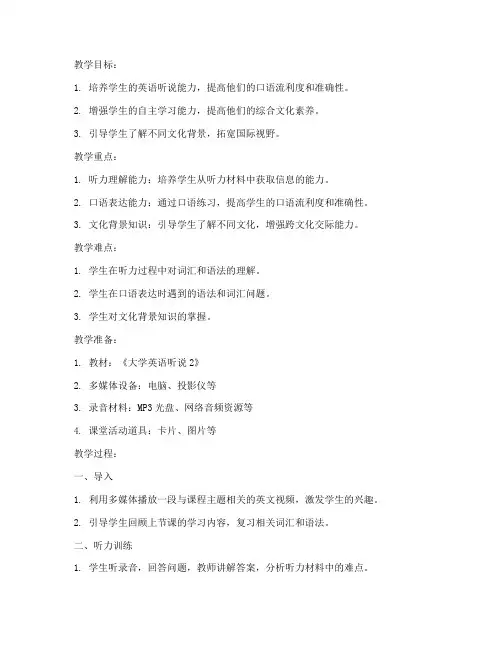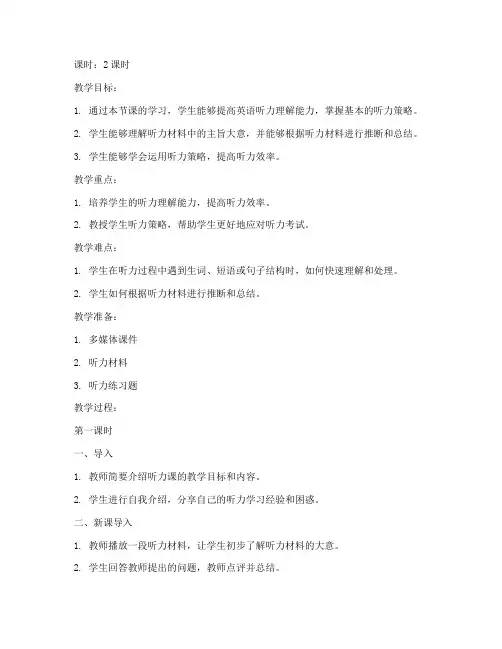现代大学英语听力2 教案
杨立民听力2教学设计(一)

杨立民听力2教学设计(一)杨立民听力2教学设计教学目标•帮助学生提高听力技能,并能够理解和运用所听到的信息•培养学生的注意力和集中能力•提高学生的听力速度和准确性教学内容1.听力训练材料的选择和使用2.听力技巧的教授和练习3.听力策略的介绍和实践教学步骤1.导入活动:播放一段简短的听力材料,让学生进行整体理解,并提问相关内容,激发学生的兴趣和注意力。
2.听力训练:根据学生的水平选择合适的听力材料,让学生进行反复听,并进行听力理解练习,如填空、选择题等。
同时,引导学生注意关键信息和语境,提高他们的听力准确性和速度。
3.听力技巧教授:介绍一些提高听力技能的方法和技巧,如捕捉关键词、推测意义、注意词汇搭配等。
通过讲解和示范,让学生明白如何运用这些技巧来提高自己的听力能力。
4.听力练习:让学生进行有针对性的听力练习,根据不同的技巧和策略要求学生进行不同的操作,如抓主旨、推测意义、判断正误等。
5.反馈和讨论:根据学生的表现,给予及时的反馈和指导,并进行听力策略的讨论和分享,让学生相互学习和借鉴,提高自己的听力水平。
6.总结和巩固:总结本节课的学习内容和收获,强调学生在日常生活中的听力应用,并布置一些听力任务作为家庭作业,以巩固和拓展学生的听力能力。
教学评估•学生的听力答案和表现•学生在听力练习中的主动参与程度•学生在听力讨论和分享环节中的表现•学生在听力任务作业中的完成情况和反馈拓展活动•分组或小组活动,进行听力游戏和竞赛,以增加趣味性和互动性•鼓励学生每天进行一定时间的英语听力训练,培养良好的听力习惯和技能。
现代大学英语听力2册unit 8

In listening, take notes about the key information ----the six winners(their names, nationalities and contributions). Check their notes.
Teaching method:Let the students understand the main idea of this passage and take notes about key information.
Teaching step:
1.Warming up:
Look at some pictures and review some information that we have learned in Unit 7.
boundary:分野
radical:激进的
AboutTony Blair:
He is a BritishLabour Partypolitician who served as thePrime Ministerof theUnited Kingdomfrom 1997 to 2007.
Left and right:
millennium: a period of 1,000 years
3.Listen to the first part twice and try to finish exercise A and C.
Before listening, go over the questions quickly.
教案
现代大学英语听力2_教案

课时:2课时教学目标:1. 培养学生良好的听力习惯,提高听力理解能力。
2. 使学生掌握听力技巧,提高听力效率。
3. 帮助学生了解英美文化背景,增强跨文化交际能力。
教学内容:1. 单元主题:日常生活场景2. 听力材料:包含对话、短文和讲座等形式3. 听力题型:选择题、判断题、填空题等教学过程:第一课时一、导入1. 教师简要介绍本单元主题,激发学生学习兴趣。
2. 引导学生回顾上节课所学内容,为新课做好铺垫。
二、新课导入1. 教师播放听力材料,学生集中注意力听。
2. 学生跟读材料,模仿语音、语调。
三、听力训练1. 选择题:教师播放听力材料,学生根据问题选择正确答案。
2. 判断题:教师播放听力材料,学生判断正误。
3. 填空题:教师播放听力材料,学生根据所听内容填写空缺的单词或短语。
四、听力技巧讲解1. 概括归纳:引导学生从整体上把握听力材料的主旨大意。
2. 关键词识别:帮助学生识别听力材料中的关键词,提高听力理解能力。
3. 上下文推断:引导学生根据上下文推测未知信息。
五、课堂小结1. 教师总结本节课所学内容,强调重点。
2. 学生分享自己的学习心得,提出疑问。
第二课时一、复习上节课所学内容1. 教师提问,检查学生对上节课内容的掌握情况。
2. 学生回答问题,巩固所学知识。
二、听力材料分析1. 教师播放听力材料,学生认真听。
2. 学生分析材料中的语言特点、文化背景等。
三、小组讨论1. 将学生分成小组,讨论听力材料中的问题。
2. 各小组汇报讨论结果,教师点评。
四、听力技巧练习1. 教师播放听力材料,学生运用所学技巧进行听力训练。
2. 学生互相交流,分享听力心得。
五、课堂小结1. 教师总结本节课所学内容,强调重点。
2. 学生分享自己的学习心得,提出疑问。
教学评价:1. 学生对听力材料的理解程度。
2. 学生运用听力技巧的能力。
3. 学生对英美文化背景的了解程度。
教学反思:1. 教师根据学生的反馈,调整教学方法和内容。
大学英语2试听说教案

一、教学目标1. 知识目标:- 熟悉并掌握与日常生活相关的英语口语表达。
- 理解并运用常用的听力技巧,提高听力理解能力。
2. 能力目标:- 培养学生的英语听说能力,提高学生的口语流利度和准确性。
- 增强学生的跨文化交流意识和实际应用能力。
3. 情感目标:- 激发学生对英语学习的兴趣,提高学生的自信心。
- 培养学生的团队合作精神和自主学习能力。
二、教学内容1. 口语部分:- 主题:日常问候与自我介绍。
- 内容:如何用英语进行日常问候、自我介绍,以及如何进行简单的交流。
2. 听力部分:- 主题:日常生活场景对话。
- 内容:涉及购物、餐厅点餐、交通出行、天气等场景的对话。
三、教学过程第一课时1. 导入:- 利用多媒体展示不同场景的图片,引导学生进入英语学习氛围。
2. 口语训练:- 教师带领学生进行日常问候与自我介绍的练习。
- 学生分组进行角色扮演,模拟真实场景进行交流。
3. 听力训练:- 播放日常生活场景对话录音,学生听后回答相关问题。
- 教师讲解听力技巧,如预测、抓关键词等。
第二课时1. 复习:- 复习上一节课的内容,巩固所学知识。
2. 口语训练:- 学生分组进行日常问候与自我介绍的练习,互相纠正发音和语法错误。
3. 听力训练:- 播放不同场景的对话录音,学生分组讨论并回答相关问题。
- 教师讲解听力技巧,如如何捕捉关键信息等。
四、教学手段1. 多媒体课件:展示图片、视频等,丰富教学内容。
2. 录音设备:播放听力材料,提高学生的听力水平。
3. 角色扮演:模拟真实场景,提高学生的口语表达能力。
五、教学评价1. 课堂表现:观察学生的参与度和积极性。
2. 口语表达:评估学生的口语流利度和准确性。
3. 听力理解:通过测试或提问,评估学生的听力水平。
六、教学反思1. 注重学生的个体差异,因材施教。
2. 创设真实、有趣的英语学习环境,激发学生的学习兴趣。
3. 注重培养学生的听说能力,提高学生的英语综合运用能力。
大学英语听说2教师版教案

教学目标:1. 培养学生的英语听说能力,提高他们的口语流利度和准确性。
2. 增强学生的自主学习能力,提高他们的综合文化素养。
3. 引导学生了解不同文化背景,拓宽国际视野。
教学重点:1. 听力理解能力:培养学生从听力材料中获取信息的能力。
2. 口语表达能力:通过口语练习,提高学生的口语流利度和准确性。
3. 文化背景知识:引导学生了解不同文化,增强跨文化交际能力。
教学难点:1. 学生在听力过程中对词汇和语法的理解。
2. 学生在口语表达时遇到的语法和词汇问题。
3. 学生对文化背景知识的掌握。
教学准备:1. 教材:《大学英语听说2》2. 多媒体设备:电脑、投影仪等3. 录音材料:MP3光盘、网络音频资源等4. 课堂活动道具:卡片、图片等教学过程:一、导入1. 利用多媒体播放一段与课程主题相关的英文视频,激发学生的兴趣。
2. 引导学生回顾上节课的学习内容,复习相关词汇和语法。
二、听力训练1. 学生听录音,回答问题,教师讲解答案,分析听力材料中的难点。
2. 学生分小组讨论听力材料,分享自己的理解和感受。
三、口语训练1. 教师设置情景,引导学生进行口语对话。
2. 学生分小组进行角色扮演,练习口语表达。
3. 教师巡回指导,纠正学生的发音和语法错误。
四、文化背景知识1. 教师介绍与课程主题相关的文化背景知识。
2. 学生讨论文化差异,分享自己的观点。
五、小结1. 教师总结本节课的学习内容,强调重点和难点。
2. 学生回顾本节课的学习成果,提出自己的疑问。
六、作业布置1. 完成教材中的相关练习。
2. 收集与课程主题相关的英文资料,进行自主学习。
教学反思:1. 教师应根据学生的实际情况调整教学内容和进度。
2. 注重培养学生的自主学习能力,引导学生主动参与课堂活动。
3. 运用多种教学手段,激发学生的学习兴趣,提高他们的英语听说能力。
4. 关注学生的文化背景知识,增强他们的跨文化交际能力。
大学英语2听力课教案

课时:2课时教学目标:1. 通过本节课的学习,学生能够提高英语听力理解能力,掌握基本的听力策略。
2. 学生能够理解听力材料中的主旨大意,并能够根据听力材料进行推断和总结。
3. 学生能够学会运用听力策略,提高听力效率。
教学重点:1. 培养学生的听力理解能力,提高听力效率。
2. 教授学生听力策略,帮助学生更好地应对听力考试。
教学难点:1. 学生在听力过程中遇到生词、短语或句子结构时,如何快速理解和处理。
2. 学生如何根据听力材料进行推断和总结。
教学准备:1. 多媒体课件2. 听力材料3. 听力练习题教学过程:第一课时一、导入1. 教师简要介绍听力课的教学目标和内容。
2. 学生进行自我介绍,分享自己的听力学习经验和困惑。
二、新课导入1. 教师播放一段听力材料,让学生初步了解听力材料的大意。
2. 学生回答教师提出的问题,教师点评并总结。
三、听力策略讲解1. 教师讲解听力策略,如预读、预测、抓住关键词、注意句子结构等。
2. 学生跟随教师进行听力策略练习。
四、听力材料精听1. 教师播放听力材料,学生认真聆听并记录关键词。
2. 教师暂停播放,学生回答问题,教师点评并总结。
五、听力材料泛听1. 教师播放听力材料,学生自由听,尽量理解材料的大意。
2. 学生分享自己的理解,教师点评并总结。
六、课堂小结1. 教师总结本节课的重点内容,强调听力策略的重要性。
2. 学生回顾本节课所学内容,提出自己的疑问。
第二课时一、复习导入1. 教师回顾上节课的重点内容,检查学生的学习情况。
2. 学生分享自己的学习心得和体会。
二、听力材料精听1. 教师播放听力材料,学生认真聆听并记录关键词。
2. 教师暂停播放,学生回答问题,教师点评并总结。
三、听力材料泛听1. 教师播放听力材料,学生自由听,尽量理解材料的大意。
2. 学生分享自己的理解,教师点评并总结。
四、听力策略巩固1. 教师引导学生运用听力策略,提高听力效率。
2. 学生进行听力策略练习,教师点评并总结。
现代大学英语第二版2教案
一、课题:《现代大学英语第二版》Unit 2二、教学目的:1. 帮助学生掌握本单元的核心词汇和短语。
2. 提高学生的阅读理解能力,培养学生的批判性思维。
3. 通过课堂讨论,增强学生的口语表达能力和团队合作精神。
三、教学重点:1. 理解课文内容,掌握课文中的关键信息和观点。
2. 熟练运用课文中的核心词汇和短语。
3. 培养学生的阅读策略,提高阅读速度和理解力。
四、教学难点:1. 课文中的复杂句型和长难句的理解。
2. 学生对课文主题的深入挖掘和批判性分析。
五、教学过程:(一)导入新课(5分钟)1. 引导学生回顾上一单元所学内容,为新单元的学习做好铺垫。
2. 提出本单元的学习目标,让学生对学习内容有所预期。
(二)讲授新课(30分钟)1. 介绍课文背景和作者,激发学生的阅读兴趣。
2. 逐段讲解课文,引导学生理解课文内容。
3. 分析课文中的复杂句型和长难句,帮助学生掌握语法知识。
4. 针对课文中的关键信息和观点,引导学生进行讨论和分析。
(三)巩固练习(15分钟)1. 设计相关练习题,让学生巩固所学知识。
2. 学生独立完成练习,教师巡视指导。
(四)课堂讨论(15分钟)1. 提出与课文主题相关的问题,引导学生进行讨论。
2. 鼓励学生发表自己的观点,培养学生的批判性思维。
3. 教师总结讨论结果,强调重点内容。
(五)归纳小结(5分钟)1. 回顾本节课所学内容,强调重点和难点。
2. 布置课后作业,要求学生巩固所学知识。
六、教具准备:1. 课文教材《现代大学英语第二版》2. 黑板或投影仪3. 练习题4. 讨论问题七、作业布置:1. 阅读课文,完成课后练习题。
2. 搜集与课文主题相关的资料,为下节课的讨论做准备。
八、教学反思:1. 课后对学生的课堂表现进行评价,了解学生的学习效果。
2. 根据学生的反馈,调整教学方法和内容,提高教学质量。
现代大学英语听力2-Unit-5-Education
New Words
nursery school: a small preschool for small children faint:
v. pass out from weakness, physical or
emotional distress due to a loss of blood supply to the brain;
compulsory (free) education: students are compelled to attend school longer by compulsory schooling laws; Plato's The Republic popularized the concept of compulsory education in Western intellectual thought.
recurrent education:education for people who are in the world of work or in a period of unemployment, who have leisure time or are retired, and who return at intervals to organized learning
Pre-schoolБайду номын сангаасeducation …etc.
Task 2
Objectives and Tips:
Try to clarify the different stages of schooling at different age.
Do not neglect the details.
Task 1
现代大学英语听力2教案
课时:2课时教学目标:1. 培养学生听懂英语日常生活中的常用词汇和句型。
2. 提高学生的英语听力理解能力和实际应用能力。
3. 帮助学生了解西方文化,拓宽视野。
教学重点:1. 词汇:掌握听力材料中出现的关键词汇和短语。
2. 句型:掌握听力材料中的常用句型。
3. 文化:了解西方文化背景知识。
教学难点:1. 词汇理解:学生需要准确理解听力材料中的词汇。
2. 句型理解:学生需要准确理解听力材料中的句型。
3. 文化理解:学生需要理解西方文化背景知识。
教学准备:1. 教学课件2. 听力材料3. 录音设备教学过程:第一课时一、导入1. 老师简要介绍听力材料的内容,激发学生的学习兴趣。
2. 学生自由讨论,谈谈自己对听力材料的看法。
二、词汇学习1. 老师带领学生学习听力材料中的关键词汇,如:文化、生活、工作等。
2. 学生通过小组讨论,巩固所学词汇。
三、句型学习1. 老师讲解听力材料中的常用句型,如:How are you?、What’s your name?等。
2. 学生模仿老师,练习句型。
四、听力练习1. 学生独立完成听力练习,老师巡回指导。
2. 学生汇报答案,老师点评。
五、总结1. 老师总结本节课的学习内容,强调重点和难点。
2. 学生回顾所学内容,巩固记忆。
第二课时一、复习1. 老师带领学生复习第一节课所学的内容。
2. 学生回答问题,巩固所学知识。
二、听力练习1. 学生独立完成新的听力练习,老师巡回指导。
2. 学生汇报答案,老师点评。
三、拓展1. 老师介绍与听力材料相关的西方文化背景知识。
2. 学生分享自己对西方文化的了解。
四、总结1. 老师总结本节课的学习内容,强调重点和难点。
2. 学生回顾所学内容,巩固记忆。
五、布置作业1. 学生完成课后练习题。
2. 学生收集与听力材料相关的词汇和句型。
教学反思:1. 关注学生的学习情况,及时调整教学策略。
2. 创设轻松的学习氛围,激发学生的学习兴趣。
3. 结合西方文化背景知识,提高学生的综合素质。
大学英语听说2教案
#### 教学目标:1. 提高学生的英语听力理解能力,使他们能够理解不同场景下的英语对话和讲话。
2. 培养学生的英语口语表达能力,使他们能够流利、准确地表达自己的想法和观点。
3. 增强学生的文化意识,使他们能够更好地理解和运用英语进行跨文化交流。
4. 培养学生自主学习和合作学习的能力。
#### 教学内容:《大学英语听说教程2》第X单元(具体单元根据实际教材内容确定),主题为“日常交流”。
#### 教学方法:1. 任务型教学法:通过完成具体任务,如角色扮演、小组讨论等,提高学生的听说能力。
2. 情景教学法:通过模拟真实生活场景,让学生在实际语境中练习英语。
3. 比较分析法:通过对比不同文化背景下的交流方式,提高学生的文化意识。
#### 教学步骤:一、导入(5分钟)1. 播放与主题相关的英语视频或音频,引起学生的兴趣。
2. 引导学生讨论视频或音频中的内容,激发他们对本单元主题的好奇心。
二、听力训练(15分钟)1. 学生独立完成听力练习,教师播放听力材料,包括对话、短文等。
2. 学生填写听力原文中的空缺部分,教师讲解答案,并解释相关词汇和语法结构。
三、口语练习(20分钟)1. 角色扮演:学生根据教材中的情景对话,分组进行角色扮演。
2. 小组讨论:围绕本单元主题,学生分组讨论,并分享各自的观点和感受。
3. 演讲与辩论:学生针对某一话题进行演讲,其他学生进行提问和辩论。
四、文化背景介绍(10分钟)1. 教师介绍与主题相关的文化背景知识,如习俗、节日、人物等。
2. 学生分享自己对相关文化的了解和看法。
五、总结与反馈(5分钟)1. 教师总结本节课的学习内容,强调重点和难点。
2. 学生反馈自己的学习收获,提出疑问和建议。
#### 教学评价:1. 听力理解能力:通过听力练习的成绩,评估学生对英语听力材料的理解程度。
2. 口语表达能力:通过角色扮演、小组讨论和演讲与辩论的表现,评估学生的口语表达能力。
3. 文化意识:通过学生对文化背景知识的掌握程度,评估学生的文化意识。
- 1、下载文档前请自行甄别文档内容的完整性,平台不提供额外的编辑、内容补充、找答案等附加服务。
- 2、"仅部分预览"的文档,不可在线预览部分如存在完整性等问题,可反馈申请退款(可完整预览的文档不适用该条件!)。
- 3、如文档侵犯您的权益,请联系客服反馈,我们会尽快为您处理(人工客服工作时间:9:00-18:30)。
《现代大学英语》听力2课程教案授课时间:2014-2015第二学期授课班级:英1243授课人:何林Unit 1教案【Task 1】Warm up Exercises:A.1) She wanted to see St. Paul’s Cathedral.2) She was so surprised because she saw so many Englishmen who looked alike.3) They were all wearing dark suits and bowler hats, carrying umbrellas and newspapers.4) Because she had often read about them and seen photographs of them, who all looked as if they were wearing a uniform.5) No, he didn’t.6) He used the English saying “It takes all kinds to make a world” to prove his opinion.B.If all the seas were one sea, what a great sea it would be! And if all the trees were one tree, what a great tree it would be! And if this tree were to fall in the sea, what a great splash there would be!【Teaching materials】Yesterday morning Gretel went to the City of London. She wanted to see St. Paul's Cathedral. She was surprised to see so many Englishmen who looked alike. They were all wearing dark suits and bowler hats. They were all carrying umbrellas and newspapers. When she returned home she asked Mr clark about these strange creatures. "They must be typical English gentlemen," she said." I have often read about them and seen photographs of them. They all look as if they are wearing a uniform. Does the typical English gentleman still exist?"Mr. Clark laughed. "I've never thought about it," he answered." It's true that many of the men who work in the City of London still wear bowler hate and I suppose they are typical Englishmen. But look at this." Mr. Clark picked up a magazine and pointed at a photo of a young man. "He's just as typical, perhaps. It seems as if there is no such thing as a 'typical' Englishman. Do you know the English saying 'It takes all kinds to make a world'? That's true of all countries-including England."“Oh, just like the poem ‘If All the Seas Were One Sea’,”Gretel began to hum happily. If all the seas were one sea, what a great sea that would be! If all the trees were one tree, what a great tree that would be! And if this tree were to fall in the sea, what a great splash that would be!”Task 2【Teaching materials】A.1) people were much busier2) colder than England; minus thirty degrees; last longer3) much more mountainous; much higher and much more rocky; more beautiful4) tend to be more crowded5) the houses; smaller1) T 2) T 3) F 4) F 5) F【teaching steps】John is British but has worked in Japan. Etsuko is Japanese from Osaka, but she is studying in Britain. In the following passage you are going to hear, they are comparing life as they see it in the two countries. But before listening to it, think of the two countries and try to answer the following pre-listening questions.John: I found that living in Japan, people were busier. They seem to work the whole day. Etsuko: Yes, that’s right. We work from Monday through Saturday, even in summer. You know, summer in Japan is just horrible. It’s very, very humid and hot, and you need to shower three times a day.John: So you find it cooler in England?Etsuko: Yes, that’s right.John: Where I was living in Japan, in the North, it was much colder than England, especially in winter, minus thirty degrees centigrade. Does the winter in Osaka last longer than the winter in England?Etsuko: No, I don’t think so. December, January, February, March.John: Yes. It’s a little bit shorter if anything.Etsuko: Ever since I came here, I noticed that the countryside here in England is very beautiful. John: It’s much flatter than in Japan.Etsuko: Yes. Japan is a mountainous country and our cities are full of people. There are lots of people in a limited flat area.John: Yes, I found Japan much more mountainous than Britain, especially in the north. The mountains are much higher and much more rocky. I found it more beautiful than Britain, I think. Etsuko: Yes, if you like mountains.John: And therefore the towns and villages tend to be more crowded.Etsuko: Yes, that’s right.John: Yes. So because the cities are more crowded, the houses tend to be smaller, don’t they? Etsuko: Yes, they are very compact, and we don’t have a lot of space. In big cities we have a lot of taller buildings now.John: Is this a problem because there are more earthquakes in Japan?Etsuko: Yes, that’s right and…Task 3【exercises】A.1) In the US, people usually dance just to enjoy themselves; they don’t invite other people to watch them.2) Usually eight people dance together.3) Because people form a square in dancing with a man and a woman on each side of the square.4) He usually makes it into a song.5) They wear old-fashioned clothes.B.1) F 2) T 3) F 4) F 5) T1) eight people form a square; on each side of the square2) what they should do; makes it into a song; sings it3) don’t have much time to think4) old-fashioned clothes【teaching materials】Rosa: Why don’t you have folk dances in the United States? Most countries have special dances that the people have done for many years. The dancers wear clothes from the old days. Everyone likes to watch them dance.Steve: We have folk dances, too. A lot of people belong to folk dancing groups. But when they dance, they usually do it just to enjoy themselves. They don’t invite othe r people to watch them. Rosa: Is there a folk dancing group here?Steve: I think so. There must be. There’s one in almost every city, and some big cities have several.Rosa: What are the dances like?Steve: Usually eight people dance together, four men and four women. When they start, they form a square, with a man and a woman on each side of the square. That’s why it’s called square dancing. Then there’s a man who tells the dancers what they should do. He usually makes it into a song. He sings it while they dance.Rosa: Oh, that should make the dances easy!Steve: Yes, but they are very fast. They don’t have much time to think. I like to watch them, though. The dancers wear old-fashioned clothes. That makes the dances pretty to watch. Rosa: I’d l ike to watch a group dance.Steve: I’ll take you sometime.Task 4【teaching task】1) It was a time to celebrate the end of winter and the beginning of spring.2) They burned the picture of their kitchen god to bring good luck.3) The custom said the bri des must wear “something old, something new, something borrowed, and something blue” to bring good luck.4) Because they could not eat meat, eggs or dairy products during Lent, so they tried to use up these things before Lent began.5) It was a straw man made by children in Czech; it was a figure of death.6) People brought their animals to church. And before the animals went into the church people dressed them up in flowers and ribbons.【teaching materials】1) On the evening of February 3rd, people in Japanese families took one dried bean for each year of their age and threw the beans on the floor, shouting "Good luck in! Evil spirits out!" This was known as "Setsubun", a time to celebrate the end of winter and the beginning of spring.2) Before the Chinese Lunar New Year in the old days, many Chinese families burned the picture of their kitchen god to bring good luck. When Lunar New Year's Day came, they put ancw picture of the kitchen god on the wall.3) When American women got married, they sometimes followed an old custom in choosingwhat to wear on their wedding day. The custom said the bride must wear "something old, something new, something borrowed, and something blue". This was to bring good luck.4) Before Lent (a time on the Christian calendar), the people of Ponti, Italy ate an omelet made with 1,000 eggs. People could not eat meat, eggs or dairy products during Lent, so they tried to use up these things before Lent began.5) When winter ended in Czech, the children made a straw man called "Smrt", which was a figure of death. They burned it or threw it in the river. After they destroyed it, they carried flowers home to show the arrival of spring.6) January 17th was St. Anthony's Day in Mexico. It was a day when people brought their animals to church. But before the animals went into the church, the people dressed them up in flowers and ribbons. This ceremony was to protect people's animals.Task 5【exercises】A.1) F 2) T 3) F 4) T 5) F 6) T 7) TB.AdvantagesDisadvantagesLots of servants to do the workTerrible life for servantsbeautiful clothes to wearvery uncomfortable clotheslots of tea partiesboring and formal tea parties — often no men being invitedlife being slowermuch more illnessplenty of time to talk to each otherchildren left with servants all dayvery poor educationno freedom for women【teaching materials】Man: Well, I think life used to be much more fun than it is now. I mean, look at the Victorians. They had lots of servants to do all the work; they never had to do any cooking or cleaning; they just wore those beautiful dresses and went to tea parties.Woman: You must be joking! Their clothes were terribly uncomfortable and their tea parties were very formal and boring. They used to wear their hats and long gloves even when they were eating cakes and biscuits. And men were not usually invited.Man: Really? Weren't they?Woman: And think of the poor servants. What a terrible life — just cleaning and cooking for other people all the time!Man: But you hate housework!Woman: Yes, I know, but there are lots of machines now to help you with the housework. People don't need servants.Man: Maybe they don't, but life then was much slower than it is now-people nowadays are always rushing, and they never have time to stop and enjoy themselves.Woman: Life then was fine for the rich, but it was dreadful for the poor. There was much more illness. They didn't have the money to pay doctors, and they often used to die of illnesses that don't exist in England now.Man: Maybe. But people used to talk to each other, play the piano or play cards together. Nowadays people just sit in front of the television for hours and never talk to each other. Woman: I agree with you about television; but what about their children? They left their Children with the servants all day. Children hardly ever saw their parents! And the clothes they had to wear! Horrible, tight, uncomfortable, grown-up clothes. Children have a much better life now than they used to, and schools and education are much better too.Man: I hate school.Woman: And look at opportunities for women. In those days, women used to stay at home, play the piano, change their clothes several times a day and have tea parties. What a life! They didn't have any freedom at all. I'm very happy living now. I can work, have a career, do what I want to. Man: You mean you can work hard all your life like a Victorian servant.Woman: Life isn't all tea parties, you know.Task 6【exercises】A.1) b 2) a 3) c 4) aB.1) family unit; process; change; used to be; the extended; the nuclear2) job patterns; progressed; agricultural; industrial; forced; job opportunities; split up3) traditional; family; expanded; other living arrangementsC.1) mother, father, children, and some other relatives, such as grandparents, living in the same house or nearby2) only the parents and the children3) previously married men and women marry again and combine the children from former marriages into a new family【teaching materials】The American family unit is in the process of change. There used to be mainly two types of families: the extended and the nuclear. The extended family most often included mother, father, children, and some other relatives, such as grandparents, living in the same house or nearby. Then as job patterns changed and the economy progressed from agricultural to industrial, people were forced to move to different parts of the country for job opportunities. These moves split up the extended family. The nuclear family became more prevalent; this consisted of only the parents and the children. Now besides these two types of traditional groupings, the word "family" is being expanded to include a variety of other living arrangements.Today's family can be made up of diverse combinations. With the divorce rate nearly one in two, there is an increase in single parent homes: a father or mother living with one or morechildren. "Blended families" occur when previously married men and women marry again and combine the children from former marriages into a new family. On the other hand, some couples are deciding not to have any children at all, so there is an increase in childless families. There are also more people who live alone: single, widowed, divorced. Now one in five Americans lives alone.Task 7【keys】A.MenWomenBothStudy subjects like history or English√Study engineering√Go to university to get good jobs√Look for a good job because they want a good husband√Look for a good job because they want to be successful√Work for a lifetime√Work up to ten years√Get married by twenty-seven√Cook the meals√Look after the children√Go out for a drink after work√Come home by four o'clock in the afternoon√B.1) c 2) c 3) a 4) b 5) c 6) c 7) c【keys】In Japan both men and women go to university and both men and women study the arts such as history or English. But very few women study science, medicine or engineering. In engineering classes of thirty or forty students, there may be only one or two women. Men and women both go to university in order to get good jobs: men want to work for a big company, be successful, earn a lot of money and support a family; women, on the other hand, want to work for a big company because they have a better chance of meeting a successful man and getting married. This is changing, however, as Japanese women begin to think about their own careers. They have began to take jobs which they like rather than jobs in order to find a husband.Men work for their whole lives and usually stay with the same company. A woman may work up to ten years, but after that she usually gets married. Most women are married by the age of twenty seven, then they stay at home and look after the children. A man does not cook or look after the children. When he comes home, his meal must be ready. The woman may go out in the afternoon, shopping with her friends or having a chat, but she must go back home by four o'clock to prepare the meal. Then she may have to wait a long time for her husband to come home. Often he has to go out for a drink after work: if he doesn't he may not rise very high in the company. After her children grow up, a woman can go back to work, but it is not easy. If her former company takes older women back, she might be lucky. But most women find it difficult to find a job when they are older.Task 8【keys】A.1) a 2) c 3) b 4) c 5) c 6) b 7) c 8) bB.1) T 2) T 3) F 4) F 5) T 6) F 7) F 8) F 9) T 10) F【teaching materials】Matthew: Geth, how do people set about getting married in England?Geth: I suppose the most common way is still for people to go home. For example, people who live in London now will go back to their homes in the provinces where they'll meet all their relatives and their parents, and they'll get married in a church, with the bride wearing white, the traditional white. Then they'll go off and have a booze-up with their relatives and friends and a jolly good time will be had by all. Otherwise you can get married in a registry office, which means you turn up with your bride-to-be or bridegroom-to-be with two witnesses only. The ceremony takes about five minutes, I suppose. You sign the form and that's it.Matthew: There are many today who say that marriage is a complete waste of time. What's your view of marriage in the twentieth century?Goth: Well, I live in London as you know. I think in London, the tendency is to... for a... boy and girl, man or woman to live together before marriage and often to live together without any prospect of marriage at all. I think this probably is... is true of London and the other big cities than elsewhere, because after all people in London are living in a big place where home ties are obviously less restrictive. They can do more or less as they please and I think this is the pattern. Matthew: But do you think it helps for people to live together before taking their vows?Geth: I think in a sense the habit of living together before marriage may, in a strange sort of way, make marriage stronger, because after all the people will know each other better when they do get married and it might be suggested that divorce would be less likely between such a couple.Matthew: Sue, you've been married for two or three years now. How's it working out?Sue: I think it's a successful marriage. It's... I mean, it's difficult to say why, because we basically suit each other very much. We have a good friendship, apart from anything else, and, you know, we just go together very well because we respect each other's freedom and individuality, but on the other hand we really need each other, you know, it's...Matthew: What about.., have you thought of having children?Sue: Well, obviously, like most young couples, we have thought about it, but, you know, we both feel rather, sort of, loath to lose our freedom just yet. I think we'll probably wait another few years.Matthew: Is it easy in England today to people to get divorced, or is that quite difficult?Chris: I think technically it's probably fairly easy, I think, because I'm not English but, I think technically it's fairly easy to be... to get divorced. But it's not just the technicality of it which is the problem. Divorce is... is a social stigma which people can probably Cope with to varying degrees, but it's also a lot easier for the man because the woman, after she is divorced is, in fact, frowned upon by... by a lot of people in society. She is... is... at a... a much more difficult social position in terms of... of meeting other men, or whatever, simply because she is a divorcee.Task 9【keys】Social customs and ways of behaving change. But they do not necessarily always change for the better. Things which were considered impolite many years ago are now acceptable. Just a few years ago, it was considered impolite behaviour for a man to smoke on the street. No man whothought of himself as being a gentleman would make a fool of himself by smoking when a lady was in the room.The important thing to remember about social customs is not to do anything that might make other people feel uncomfortable —especially if they are your guests. There is a story about a rich nobleman who had a very formal dinner party. When the food was served, one of the guests started to eat his peas with a knife. Other guests were amused or shocked, but the nobleman calmly picked up his knife and began eating in the same way. It would have been bad manners to make his guest feel foolish or uncomfortable.。
